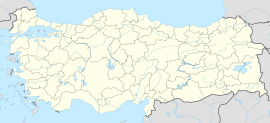İpsala (Ancient Greek: Κύψελα, romanized: Kýpsela; Greek: Ύψαλα, romanized: Ύpsala) is a town in Edirne Province in northwestern Turkey. It is the seat of İpsala District.[2] Its population is 8,546 (2022).[1] It is the location of one of the main border checkpoints between Greece and Turkey. The Greek town opposite İpsala is Kipoi.
İpsala | |
|---|---|
| Coordinates: 40°55′18″N 26°22′55″E / 40.92167°N 26.38194°E | |
| Country | Turkey |
| Province | Edirne |
| District | İpsala |
| Government | |
| • Mayor | Mehmet Kerman (AKP) |
| Elevation | 17 m (56 ft) |
| Population (2022)[1] | 8,546 |
| Time zone | UTC+3 (TRT) |
| Postal code | 22400 |
| Area code | 0284 |
| Website | www |

The state road D.110 (European route E90) connects the border checkpoint İpsala with Tekirdağ at the coast of Marmara Sea. The town consists of 6 quarters: Kapucu, Saraçilyas, Bayrambey, Köprü, Bozkurt and Fatih.[3]
History
editIn Roman and Byzantine times, this was the town of Cypsela, which belonged to the Roman province of Rhodope, whose capital and metropolitan see was Traianopolis. During the reign of Orhan, it came under the rule of the Ottoman Empire.
From the 7th century onward, the bishopric of Cypsela, initially a suffragan of Traianopolis, appears in the Notitiae Episcopatuum as an autocephalous archdiocese. Its bishops Georgius and Theophylactus were present respectively at the Second Council of Constantinople (553) and the Second Council of Nicaea (787). Stephanus was at both the Council of Constantinople (869) and the Council of Constantinople (879).[4][5] No longer a residential bishopric, Cypsela is today listed by the Catholic Church as a titular see.[6]
Climate
editİpsala has a hot-summer Mediterranean climate (Köppen: Csa),[7] with hot, dry summers, and somewhat cold, moderately wet winters.
| Climate data for İpsala (1991–2020) | |||||||||||||
|---|---|---|---|---|---|---|---|---|---|---|---|---|---|
| Month | Jan | Feb | Mar | Apr | May | Jun | Jul | Aug | Sep | Oct | Nov | Dec | Year |
| Mean daily maximum °C (°F) | 7.9 (46.2) |
10.0 (50.0) |
13.4 (56.1) |
18.6 (65.5) |
24.5 (76.1) |
29.5 (85.1) |
32.1 (89.8) |
32.3 (90.1) |
27.4 (81.3) |
20.9 (69.6) |
14.9 (58.8) |
9.4 (48.9) |
20.1 (68.2) |
| Daily mean °C (°F) | 4.0 (39.2) |
5.6 (42.1) |
8.5 (47.3) |
12.9 (55.2) |
18.1 (64.6) |
22.8 (73.0) |
25.0 (77.0) |
25.0 (77.0) |
20.5 (68.9) |
15.1 (59.2) |
10.2 (50.4) |
5.6 (42.1) |
14.5 (58.1) |
| Mean daily minimum °C (°F) | 0.8 (33.4) |
1.9 (35.4) |
4.4 (39.9) |
7.9 (46.2) |
12.5 (54.5) |
16.7 (62.1) |
18.6 (65.5) |
18.5 (65.3) |
14.6 (58.3) |
10.5 (50.9) |
6.4 (43.5) |
2.4 (36.3) |
9.6 (49.3) |
| Average precipitation mm (inches) | 68.47 (2.70) |
63.17 (2.49) |
66.83 (2.63) |
43.61 (1.72) |
43.11 (1.70) |
37.57 (1.48) |
21.78 (0.86) |
11.04 (0.43) |
33.49 (1.32) |
74.16 (2.92) |
81.5 (3.21) |
84.97 (3.35) |
629.7 (24.79) |
| Average precipitation days (≥ 1.0 mm) | 7.3 | 5.9 | 6.9 | 5.8 | 5.2 | 4.7 | 2.7 | 2.2 | 3.4 | 5.2 | 6.1 | 7.3 | 62.7 |
| Average relative humidity (%) | 81.3 | 77.9 | 75.9 | 72.0 | 68.7 | 64.5 | 60.4 | 60.3 | 66.2 | 74.9 | 79.5 | 81.4 | 71.8 |
| Source: NOAA[8] | |||||||||||||
References
edit- ^ a b "Address-based population registration system (ADNKS) results dated 31 December 2022, Favorite Reports" (XLS). TÜİK. Retrieved 13 March 2023.
- ^ İlçe Belediyesi, Turkey Civil Administration Departments Inventory. Retrieved 1 March 2023.
- ^ Mahalle, Turkey Civil Administration Departments Inventory. Retrieved 1 March 2023.
- ^ Michel Lequien, Oriens christianus in quatuor Patriarchatus digestus, Paris 1740, Vol. I, coll. 1203-1204
- ^ Raymond Janin, v. Cypsela, in Dictionnaire d'Histoire et de Géographie ecclésiastiques, vol. XIII, Paris 1956, coll. 1161-1162
- ^ Annuario Pontificio 2013 (Libreria Editrice Vaticana 2013 ISBN 978-88-209-9070-1), p. 870
- ^ "Table 1 Overview of the Köppen-Geiger climate classes including the defining criteria". Nature: Scientific Data.
- ^ "World Meteorological Organization Climate Normals for 1991-2020 — İpsala". National Oceanic and Atmospheric Administration. Retrieved January 15, 2024.

